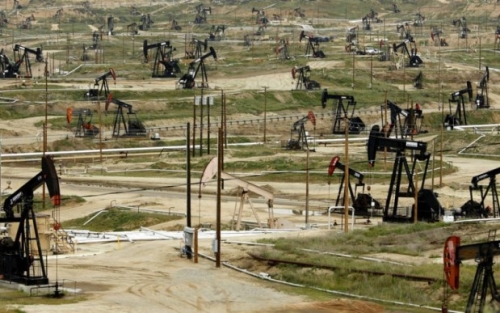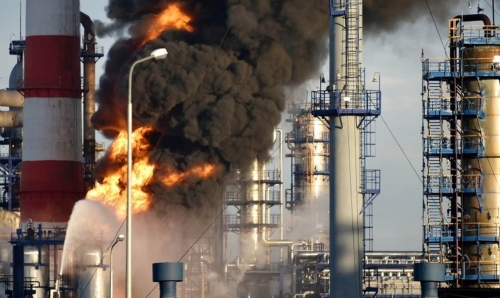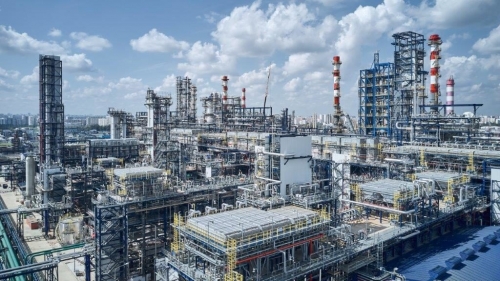Oil prices continued their decline this week, reaching four-year lows due to escalating US-China trade tensions, coupled with increased supply from OPEC+ and broader concerns over a potential global recession.
BKR Rig Count | The total active drilling rigs in the United States decreased by 7 last week, to 583. Oil rigs dropped by 9 to 480, and gas rigs increased by 1 to 97. Rig count in the Permian Basin dropped by 5 to 289 | Apr 11 | BKR NAM Rig Count
US Crude Inventories, excluding those in the Strategic Petroleum Reserve (SPR), increased by 2.6 MMbbl to 442.3 MMbbl (about 5% below the 5y average for this time of year). On the products side, gasoline decreased by 1.6 MMbbl (same as the 5y average). Distillate fuels decreased by 3.5 MMbbl (9% below the 5y average). Total commercial petroleum inventories increased by 1.2 MMbbl | Apr 4 | EIA Weekly Report
US Slashes Its Outlook for Global Oil Demand Growth in 2025. Global oil demand is now expected to grow by about 900,000 b/d in 2025, according to the EIA. That’s about 400,000 b/d lower than last month’s estimate. US crude prices have plunged more than 15% in April and are trading near a four-year low as traders assess the outlook for demand amid Trump’s salvos with major trading partners. There’s growing concern that an escalation of the trade war between the world’s two biggest economies (the US and China) will bring lasting damage to global growth | Apr 10 | Bloomberg
US Crude Flows to China Trickle to Near Zero After Tariff Blitz. Oil shipments from the US to China have been on the decline for much of 2025, thanks to US President Donald Trump’s successive rounds of tariffs. Beijing’s retaliation, raising tariffs on US imports to 84%, plus the latest US hike in duties on China to 125%, have only darkened the picture further. “With China imposing 84% tariffs on goods from the US, the cost of US crude would be almost double — $51 a barrel more expensive, based on $61 WTI,” said Ivan Mathews, head of APAC analysis for Vortexa. US crude imports to China will “likely dwindle to zero” he added. Some of that crude would instead be going to other buyers in Asia. China, meanwhile, will likely fill the gap with supply from Middle Eastern producers like Oman or the United Arab Emirates, although it could also ramp up its buying of sensitive crude, including from Iran and Russia | Apr 10 | Bloomberg
Goldman Sachs said Brent has the outside potential to fall below $40 a barrel under “extreme” outcomes as the trade war flares and supplies rise. “In a more extreme and less likely scenario with both a global GDP slowdown and a full unwind of OPEC+ cuts, which would discipline non-OPEC supply, we estimate that Brent would fall just under $40 a barrel in late 2026,” analysts including Yulia Grigsby said. That view does not represent the bank’s current base-case outlook, which has Brent at $55 next December. Assuming a “typical” US recession, plus baseline expectations for supply, Brent was seen at $58 a barrel this December, and $50 in the same month next year, the Goldman analysts said | Apr 8 | Bloomberg
Societe Generale sees the Trump administration’s tariffs to reduce China’s gross domestic product by 2 percentage points this year. The bank said it’s shaving about 350,000 b/d off its pre-tariff oil demand growth estimate for the rest of 2025. Previously, SocGen expected crude consumption to climb by 1 million b/d for the full year. While the bank’s base case doesn’t factor in a recession, that scenario could push prices into the low $50s | Apr 7 | Bloomberg
Falling oil prices won’t derail Argentina’s burgeoning shale boom unless they plunge below $45 a barrel, said the chief executive of the state-run YPF. For now, YPF is maintaining its guidance for capital investments in shale this year at about $3.2 billion. It helps that the Donald Trump administration has exempted energy shipments from his wave of import tariffs, including a 10% baseline for Argentina. The US is the no. 2 destination for Argentine shale oil. Even so, the county’s second-biggest shale oil producer, Vista Energy, warned earlier in the year that it would consider budget cuts if prices for the region’s light Medanito crude drop below $55 | Apr 10 | Bloomberg
BP has indicated that its upstream production for Q1 2025 is expected to be lower compared to the prior quarter, with slightly higher oil production, but lower gas and low carbon energy, including divestments in Egypt and Trinidad & Tobago completed end of last quarter. Base declines in the two countries were “around 90,000 boepd”. Their full-year 2025 capex guidance could be around $15bn, and BP believes the 2025 “underlying upstream production to be slightly lower than 2024, with oil production and operations broadly flat”, and gas and low carbon energy to be lower | Apr 11 | Upstream
Looking ahead
At $50/b, what happens to the US oil industry? There is a relatively rapid feedback loop between oil prices and US tight oil production. Besides production and price levels, a third dimension of the US tight oil equation is the amount of cash oil producers are under pressure to return to shareholders. A recent sensitivity analysis performed by S&P shows that at a steady WTI price of $50/b, US Lower 48 onshore production could decline by more than 1 million b/d over 12 months between December 2024 and December 2025 if the “reinvestment rate” of the upstream industry is unchanged from the current assumption of about 60%. The reinvestment rate is the share of cash flows reinvested by the industry in upstream operations, as opposed to, for example, returning cash to shareholders or paying down debt. This analysis is for US Lower 48 onshore only, i.e., excluding other areas, notably the offshore and Alaska. In a $50/b oil world, S&P believes US onshore operators would continue to prioritize returns to shareholders and thus reduce their activity to keep their reinvestment rate from rising to a large degree. US oil production changes over time will also depend on how the industry responds by innovating and reducing costs. Notably, recently imposed and forthcoming US import tariffs will put upward pressure on upstream costs. The sensitivity analysis cited above has factored in a reduction in drilling and completion costs as reduced rig and fracking crew utilization more than offsets the impact of tariffs. At $50/b, in order for the US onshore to remain flat over the course of 2025, the industry would need to reinvest about 90% of the cash flow from operations generated at that price. The remaining cash that was not allocated toward drilling and completing new wells would have to cover all payments to stakeholders — including all interest payments, dividends and other returns. Given the current debt load of the industry, we calculate that the industry would need to borrow roughly $10 billion just to pay its interest. Covering dividends would necessitate more borrowing. In the event, S&P believes that the industry would be largely unwilling to make these financial sacrifices and would reduce activity to prioritize returns to shareholders. That decision would lead to the production shrinkage outcomes with a decline of more than 1 million/bd over 12 months | Apr 8 | S&P
The International Energy Agency's (IEA) Energy and AI special report highlights the critical interdependence between artificial intelligence (AI) and the energy sector. AI's rapid rise — boosted by falling computation costs, a surge in data availability, and technical breakthroughs — has pushed AI-related S&P 500 market capitalization up by USD 12 trillion since 2022. Data centres, the backbone of AI infrastructure, saw nearly $500B in investment in 2024, and consumed about 415 terawatt-hours (TWh) of electricity globally. The report projects that data centre electricity demand will more than double to 945 TWh by 2030, exceeding Japan’s current total consumption, with AI being the primary driver.Data centers account for one-tenth of global electricity demand growth to 2030, less than the share from industrial motors, air conditioning in homes and offices, or electric vehicles.
To meet rising energy needs, the report stresses a diverse mix of energy sources: half of the new demand is expected to be covered by renewables, while natural gas and nuclear (including small modular reactors around 2030) will play crucial supporting roles.AI itself offers transformative potential for the energy sector—improving electricity network management, reducing downtime, and increasing efficiency, possibly unlocking up to 175 gigawatts (GW) of transmission capacity without building new lines. However, the sector faces major uncertainties, such as infrastructure bottlenecks and variable AI adoption rates, leading to a possible 2035 data centre electricity demand range between 700–1,700 TWh. The high case implies four times more gas-fired power generation than in the low case. The IEA urges stronger collaboration between the tech and energy industries to seize opportunities and mitigate emerging risks | Apr 10 | IEA

%20(1).png)



